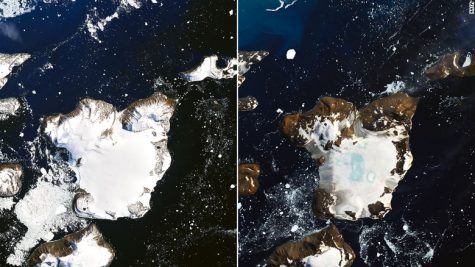Record Heatwave in Antarctica Causes Climate Change Concerns
How the decrease in global temperature is changing the south pole.
On February 5th, 2020, meteorologists recorded record high temperatures in Antarctica, and the warmer weather didn’t end until eight days later. On February 6th, the highest temperature of the heat wave was marked at Esperanza Base on the northern tip of the continent at 64.9 degrees Fahrenheit. To put it in context, that temperature was measured in Los Angeles on the same day.
However, this massive temperature increase did not get much attention until February 25th when NASA released images of Antarctica’s Eagle Island before and after the heatwave.

In just over a week, 4 inches of snow melted on Eagle Island- that’s about 20% of the island’s seasonal snow accumulation. Dry spots can be seen around the edges of the island as well as melted ponds at the center of the island.
Why is the heat wave occurring?
NASA attributes this heat wave to high pressure over Cape Horn’s archipelago, allowing warm temperatures to build up and travel. Strong winds that cross the southern hemisphere usually protect Antarctica’s northernmost peninsula from these traveling temperatures, but those winds have been unusually weak. Sustained high temperatures like those recorded in February only started occurring in the 21st century, raising concern about the effect of climate change on the region.
What does this mean for climate change?
Although it is summer in Antarctica, temperatures this high are very uncommon to the region. According to the World Meteorological Organization, the heat wave is consistent with trends seen in Antarctica over the past few years. Climate scientists are on high alert after an iceberg the size of Atlanta broke off of an Antarctica and researchers recorded a dramatic decline in Antarctic penguin colonies within the same week as the start of the heatwave. The iceberg likely broke off as a result of warmer sea temperatures due to anthropogenic heat-trapping gas pollution. In conjunction with the melting snow caused by the heatwave- which climate scientist Xavier Fettweis notes as the highest contributor to sea level rise this summer- rising sea levels are a massive threat to global coastlines. Antarctica’s ice sheets are enough to raise global sea levels by almost 200 feet.
Warmer temperatures overall in Antarctica are not only leading to the rapid melting of ice caps and increase in global sea levels- they are affecting animals that inhabit the sensitive habitat. A recent survey took place on Elephant Island, a mountainous island off the coast of Antarctica, recording that the number of Antarctic penguins that inhabit the region is half of what it was when the last survey took place in 1971. Ornithologists attribute this decline to a decrease in the availability of krill, the penguins main food source. Krill is dependent on the presence of ice, and as climate change affects ice, the food chain is also affected due to the declining numbers of krill.
While the heat wave was part of a specific weather event, and the iceberg and decline in penguin population are long term effects of climate change, climate scientists note that extreme weather events like this have only become more common as the climate changes.
With February temperatures logged, the Antarctic Peninsula is one of the fastest warming regions on the planet. A meteorologist at Arizona State University, Randall Cerveny says that “Our polar regions are kind of the canary in the mine. They are a more sensitive environment, so they are a warning system to other areas of the world.”








